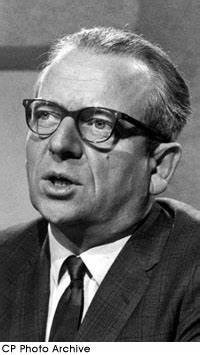TV and Internet News: “You Can’t Tell What’s True and What’s BS”
From Earl Cameron to The Moose Jaw Express
How Selling the Sizzle Not the Steak Shaped News
News announcer Earl Cameron’s broadcasting career overlapped massive changes in News Reporting. Earl was born in Moose Jaw in 1915. His career started with a summer job at Radio Station CHAB, Moose Jaw. In 1939 Earl was hired full time by CHAB. From Moose Jaw he moved to Winnipeg and from there to CBC Radio in Toronto.
On March 27, 1943, the Moose Jaw Times Herald reported, “Mr. Earl Cameron, a popular member of the local radio station staff for the past four years, has accepted a position on the staff of CKY Winnipeg. Mr. and Mrs. Cameron will leave Tuesday morning to take up residence in Winnipeg.”
Earl moved from CBC Radio to CBC Television in 1959 and became the face and voice of the ‘CBC Television National News Bulletin’.
CBC News was edited and prepared by Journalists. The Announcer read from the prepared script. Journalists collected news from various sources. The Announcer read the News Script without commenting or offering an opinion. The CBC presentation was in the tried and true BBC tradition. Read the news. Don’t editorialize and don’t sensationalize.
In 1966, Earl Cameron was replaced as the News Announcer by Stanley Burke. The CBC wanted a trained Journalist to read the news. Independent television was, like American Television News, becoming more and more sensational.
Earl remained an Announcer with CBC and retired in 1976. He died in Barrie, Ontario in 2005.
CBC Union Clash
CBC Announcers and CBC Journalists were represented by different Unions. Announcers were not allowed to write or edit the News script written by Journalists.
Knowlton Nash, the CBC Chief Correspondent took over the CBC National News show in 1978. He was a Journalist and participated in writing the News script. CBC News became more like American News and less like the BBC.
Sensationalism – Yellow Journalism – Sell the Sizzle not the Steak
Beginning in the Sixties, American TV Networks injected sensationalism into their news. Networks were competing for viewers; for ratings and for advertising dollars.
American news cameras and news correspondents were in Vietnam reporting sensational and horrifying events taking place in the Vietnam War.
Sensationalizing the News Was Not New
The competition between American Networks was like late 19th century newspaper Yellow Journalism ‘wars’. By 1900, New York Newspapers owned by Joseph Pulitzer and William Randolph Hearst competed for readers and advertising dollars in any way they thought possible. These newspapers sensationalized the news and ‘bent’ news reporting.
Readers of the New York World or the New York Journal couldn’t tell what was true and what was BS.
Sound familiar?
‘Selling the Sizzle not the Steak’ is a phrase coined in the 1930s by ‘America’s Salesman’, Elmer Wheeler. Although pure conjecture, News Journalism became more and more about selling the sizzle and not the steak.
“The Medium is the Message” – Professor Marshal McLuhan
While Television News Reporting was changing in the Sixties and Earl Cameron was booted from CBC TV, University of Toronto Professor Marshal McLuhan was teaching, “The Medium is the Message”.
The Medium is the method of sharing ‘content’. Chalk is the Medium when used to write content (information) on a Blackboard. Radio broadcasting is also a Medium.
The idea can get confusing. ‘Media’ is the plural of ‘Medium’ so one TV newscast is ‘the Medium’. Collectively, in any publication, on TV or Radio, the Internet, YouTube and so on are the ‘Media’.
McLuhan seems to have been saying, the Medium, such as television is used to cause distractions while presenting content, suggesting viewers should pay attention to the ‘Medium’.
TV arouses viewer’s senses. Television has sound; moving images and stimulating action. The Viewer may see accident victims stumbling from a wrecked car and then tell a reporter how he felt. The Medium of ‘Video’ captures sensational content, even if it is not important.
Motion pictures had a similar sensory impact but it was limited to the movie theatre.
TV and Internet Videos are an excellent way to manipulate society. The images arouse the senses. Viewers see images of something they like or that infuriates them.
Internet content, the actual ‘newsy information’ is mostly in Video form, like television.
Scholarly and Academic Internet research is rarely in video form. It’s written because reading is a faster way of imparting information. Much faster than watching a Video.
The Medium is the Message – not the Content
Here is the best description of what McLuhan was saying. “In (his book) Understanding Media, McLuhan describes the ‘content’ of a medium as a juicy piece of meat carried by the burglar to distract the watchdog of the mind.” (Reference: Federman, M. (2004, July 23). "What is the Meaning of the Medium is the Message?". Retrieved October 9, 2008)
War and Visual Images
Looking back to the Sixties and Seventies, Television News, and the coverage of the War in Vietnam had a profound impact. Audiences saw the horrors of war as presented by the ‘Medium’ of on the spot television recordings and rebroadcast.
The Medium had such an impact on ‘war policy’ for all countries that cameras and reporting in War Zones is banned by all sides in a military conflict. Why? Because it shapes opinion.
From Earl Cameron to The Moose Jaw Express
Next time you sit through a Television Newscast or watch an Internet Video ask yourself, “How significant is this for me?”
Maybe the way Earl Cameron announced the News was perceived as the best but maybe all the content you really need to know is in the Moose Jaw Express or on-line at Moose Jaw Today.
The views and opinions expressed in this article are those of the author, and do not necessarily reflect the position of this publication.




